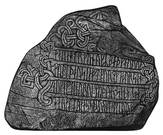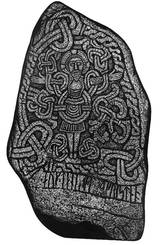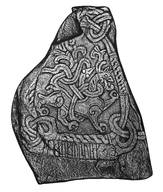- Gorm, Thyra and Harald
- The rune stones
- Gorm the Old’s rune stone
- Harald Bluetooth’s rune stone
- Basse’s rune stone
- How are rune stones read?
- The rune stones past and present
- Henrik Rantzau’s view, 1591
- Jon Skonvig, 1627
- Søren Abildgaard, 1771
- Ole Jørgen Rawert, 1819
- Adam Müller, 1835
- Jakob Kornerup, 1861
- Julius Magnus-Petersen, 1869-71
- Julius Magnus-Petersen, 1878
- Hans Andersen Kjær, 1897
- Photographs by a member of the public, 1935
- Runologist Erik Moltke, 1971
- Ludvig Stubbe-Teglbjærg’s rubbings, 1973
- Peter Henrichsen, moulding and copying in 1984
- Roberto Fortuna, 2006
- The conservation investigation 2006-08
- 3D light scanning, 2007
- Harald Bluetooth’s rune stone at home and abroad
- Pictures from Jelling
Ludvig Stubbe-Teglbjærg’s rubbings, 1973
With the permission of the keeper of national antiquities P. V. Glob, Ludvig Stubbe-Teglbjærg made rubbings of Romanesque stonework in granite, mostly in Danish churches. In its execution the rubbing method is similar to when making a rubbing of a coin with a thin piece of paper and a soft pencil. However, paper is not used for the rubbing, but instead chalk parchment and in the place of a pencil black wax is used - shoemaker’s wax or polishing wax. This is a hard wax mixture, black or brown in colour, with an appropriate quantity of carnauba wax added to make it relatively hard and to raise its melting point.
At the start of the rubbing a piece of paper is measured to a suitable size and then attached with tape. Next the wax is rubbed over the paper, after which the details of the motifs appear in black and white, but without grey tones as in a black and white photograph. The technique is to rub carefully on the background, but gradually more heavily against the edges of the stone and the figures. This produces a shading effect. In areas of deeper carving the paper has to be cut up with a razor blade. At the edge of the paper it obviously should be avoided that the wax comes into contact with the stone. The paper is now in shreds after the cutting up and must be precisely put together again with tape. The job of sticking it together is quite laborious, but produces a plan of the rubbing. Stubbe-Teglbjærg then photographically reversed the motifs so that white became black and black became white. On an absorbing table he placed photostat paper, on top of which the rubbing was laid and on this he placed an acrylic plate, which acted as a weight. After exposure the photostat is developed. The photostat paper is passed through respectively a developer bath, a stop bath and a fixer bath. After drying the photostat is mounted on 10 mm chip board to which a wooden frame is added.
In the autumn of 1973 Ludvig Stubbe-Teglbjærg was on holiday in Jelling, where he made rubbings of the three sides of the large rune stone. The resulting images show many fascinating details. For instance, Christ’s hair resembles rope and his sleeves are clearly ribbed. Such details can otherwise be hard to see on days of strong sunshine. In addition, the large cracks in the stone and the broken off areas are also clearly shown.




